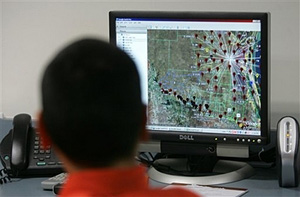 |
 |
 |
 Technology News | January 2007 Technology News | January 2007  
System Helps Border Patrol Connect the Dots
 Lynn Brezosky - Associated Press Lynn Brezosky - Associated Press


| | Senior Border Patrol Agent Pedro Villarreal operates a computer displaying apprehensions from fiscal year 2006 in the Rio Grande Valley sector of Texas. Geographic Information Systems and other mapping programs are helping Border Patrol officials to spot emerging trends in illegal activity in their sectors. (AP/Alex Jones) |
Pedro Villarreal, a Border Patrol senior agent, can get a visual on smuggling routes from the mapping system at the Rio Grande Valley sector headquarters in Edinburg, Texas. It's a real-time picture of hundreds of agents making stops, data that streams into the "Border Intelligence Center" through global positioning systems, tripped sensors and reports called in from agents in the field and on the Rio Grande.

It's a user-friendly mapping system that, in the year since beginning operations, has helped the Border Patrol uncover smuggling routes and find drugs, officials said. In December, for example, drug seizures were up 181 percent over the same time in 2005, sector chief Lynne Underdown said.

"The great thing for us is we've always dealt with statistics and numbers," said Jaime Salazar, a supervisory agent. "Now we can actually get a visual out to the agents."

The mapping system is now used all along the country's northern and southern borders, and in the Rio Grande sector, officials plan to eventually load the software into vehicles so agents can see the patterns from the field.

Kim Rossmo, a professor who runs the Center for Geospatial Intelligence and Investigation at Texas State University, which has worked with the Border Patrol, said the technology is helping patrol 2,000 miles of U.S.-Mexico border.

But Bruce Bagley of the University of Miami said the technology won't help stem the flow of drugs, which will continue to slip in from the Mexican cities of Tijuana and Nuevo Laredo simply because the two land ports are so busy. He also noted that as soon as a piece of data reached the map, it was old news.

"They will be recording historic activity, not actual or future routes," he said. "There's an incentive among smugglers to be constantly innovative. They stay one, two, three steps ahead."

Nevertheless, agents say the maps – which are monitored at the intelligence center around the clock – have helped agents find immigrant groups or narcotic smugglers almost daily.

The dots are thickest along the banks of the Rio Grande marking the U.S.-Mexico border and the two highways that head north out of the valley.

The map shows a congestion at the Border Patrol highway checkpoint at Falfurrias, where agents have had a spree of marijuana and cocaine seizures, including 10 tons over three days in December.

Ms. Underdown has said those seizures signaled desperation among smugglers. With agents using the maps to find smugglers' favorite back roads and riverbank spots, they try ever-innovative ways to conceal the drugs in rigs passing through the checkpoint.

A year ago, Mr. Salazar said, the dots would have massed at the checkpoint on the other highway north, U.S. Highway 77 – an indication smugglers have shifted.

The first Border Patrol sector to use such mapping technology was San Diego, in the late 1990s. The Rio Grande Valley sector was second, opening about a year ago. | 
 | |
 |



